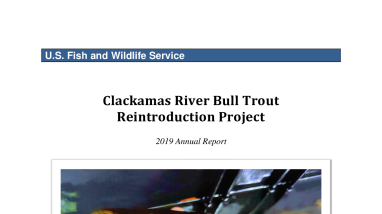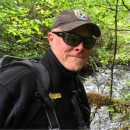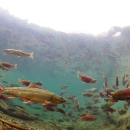Over four decades after the last Bull Trout (Salvelinus confluentus) was documented in the Clackamas River in 1963, a 2007 feasibility study determined the Clackamas River Subbasin to be a favorable candidate for Bull Trout reintroduction. A multi-agency reintroduction effort initiated in 2011, with the overall goal of re-establishing a self-sustaining population of spawning adults by the year 2030. Bull Trout were first translocated from the Metolius River Subbasin to reaches of the upper Clackamas River and select tributaries in 2011, and these releases continued through 2016. The primary objectives during the ninth year of the project (second phase) were to monitor and evaluate the reintroduction effort. During 2019, continued progress was made toward the project’s goal. The effectiveness of the reintroduction strategy was assessed by describing the seasonal distribution of translocated Bull Trout, assessing reproduction, and characterizing potential impacts to Endangered Species Act-listed salmon and steelhead in the subbasin. A video monitoring weir with an associated adult trap, passive integrated transponder (PIT) antenna and laser scaling capability was employed to assess the spawning population in Pinhead Creek. The 2019 spawning population was comprised of individuals that had been translocated as juveniles and subadults in 2012 – 2016, confirming their survival and recruitment into the adult population. The 37 individuals subsampled at the weir trap in 2019 were large, migratory fish and ranged in size from 440 – 728 mm TL. A total of 72 individual Bull Trout were captured or observed at the weir, of which 46 (64%) were female, 25 (35%) were male and 1 was unknown. Of the 46 females, 31 (67%) had been previously tagged and all 25 of the males had been previously tagged. Since all translocated fish were PIT-tagged, the presence of untagged fish suggests a portion of the spawners may have been locally-born, though the disparity between the ratio of tagged to untagged males and females may indicate an elevated rate of tag shedding among the females. Ninety-eight percent of the tagged Bull Trout that encountered the weir successfully passed upstream during the spawning season. Eighty percent of the fish that encountered the weir passed during their first encounter and 89% passed upstream by their second encounter. The laser scaling method developed for passively obtaining lengths from video of Bull Trout passing through the weir was demonstrated to be practical and the relative accuracy of the method averaged 98.2% (range: 95.8 – 100%). Redd counts have increased substantially since the inception of the reintroduction program, and the 93 redds counted during 2019 was the highest count to date. Multiple redds (N = 13) were found in Berry Creek for the first time. Caudal fin tissue was collected from nine additional untagged Bull Trout captured at the Pinhead Creek weir during 2019 and will provide the opportunity for subsequent parentage analysis. Archived tissue samples were used in a parentage analysis of embryos collected from Bull Trout redds in 2017 and parents were identified. Monitoring efforts have not provided evidence of locally-born post-emergent juveniles, or recruitment into the spawning population, both of which are major benchmarks for the reintroduction project, but may be achieved in future years. Implementation and monitoring of the reintroduction project will continue to be evaluated on an annual basis and the reintroduction strategy will be adaptively managed.
Publication date
Type of document
Report
Facility
Program
Species
FWS Focus
Ecosystem
FWS and DOI Region(s)





